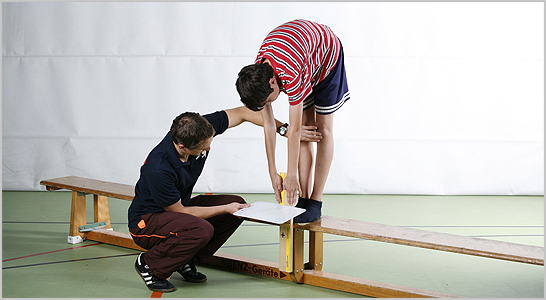Stand and Reach (St&R)
Back to overview
1. Test objective
Determination of trunk flexibility and stretching ability of the back muscles, lower extremities and long back extensors. The trunk flexion ability is seen as a combination of the stretching ability of the ischiocrural musculature and the flexion mobility of the spine.
2. Description of the task

In this test, the test person stands on a specially made wooden box (alternatively: a small box or a long bench). The upper body is slowly bent forward and the hands are brought down as far as possible with outstretched fingers in parallel along a centimeter scale. The legs are stretched throughout (to check, the test leader holds the index and middle fingers under the knee on the subject's patella tendon). The maximum stretch position attainable is to be held for two seconds. The scale reading is taken at the lowest point the fingertips touch. The subject has two attempts. Between the first and second attempt, the subject is to stand up briefly.
3. Test materials
| 3.1 | Space requirement: 2 m2 |
| 3.2 | Time and person requirements: 1 test leader can test 1 test subject within 2 minutes |
| 3.3 | Equipment and material: 1 special wooden box or 1 long bench with a centimeter scale |
4. Test setup
A centimeter scale is attached vertically to a prefabricated wooden box, which also displays values below the zero point. The zero point is the upper edge of the wooden box. Below the edge the scale is positive, above it it is negative. The test person stands without shoes on the wooden box with his toes on the edge.
5. Measurement recording
The test administrator reads off the value achieved using the numerical scale and notes down the respective scale value for both of the test person's trials. Measurements are taken in centimeters to the nearest 0.1 cm. It should be noted that the scale is positive below the brine level and negative above it. The better value from both tests is scored.
Standard values
Information on standards is given in Morrow and colleagues (1995) and Bös and colleagues (2009), among others.
6. Test instruction
This test is to check your trunk flexibility. Please stand on the box. The scale should be between your feet. The tips of your toes are on the edge of the box. Then bend forward and slowly slide your hands along the scale - as far down as possible. It is very important that you keep your legs straight and your hands parallel. When you reach the lowest point possible, say "Stop!" and stay in this position for 2 seconds.
7. Special Notes
The exercise should be performed without sports shoes.
No trial tests, because of pre-stretching.
If the test is also performed with older children, e.g. in the age group of 11-14 years, it should be noted that the legs may be longer in relation to the trunk due to the 2nd shape change, and the test subject may therefore not reach the zero level, despite normal stretching ability and flexibility of the musculature.
(MoMo test manual)
Sources of error
The test person does not keep the legs extended. The test administrator detects bending at the knee joint by placing the index and middle fingers on the patella tendon.
The test person enters the final position with a jerky movement and leaves it immediately without remaining in the position for 2 seconds.
The test person only rounds the upper back and does not use the complete range of motion in the lower back, which significantly worsens the test result.
8. Sources
Bös, K., Schlenker, L., Büsch, D., Lämmle, L., Müller, H., Oberger, J., Seidel, I., Tittlbach, S. (2009). Deutscher Motorik-Test 6-18 (DMT 6-18). Hamburg: Czwalina
Morrow, J.R., Jackson, A.W., Disch, J.G. & Mood, D.P. (1995). Measurement and evaluation in human performance. Champaign: Human Kinetics.
Worth, A., Woll, A., Albrecht, C., Karger, C., Mewes, N., Oberger, J., Schlenker, L., Schmidt, S. Wagner, M. & Bös, K. (2015) MoMo-Längsschnittstudie „Physical Fitness and Physical Activity as Determinants of Health Development in Children and Adolescents“. Testmanual zu den motorischen Tests und den anthropometrischen Messungen. Karlsruhe: Scientific Publishing.
